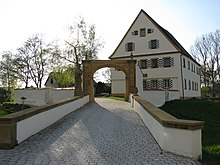Unterschneidheim
| coat of arms | Germany map | |
|---|---|---|

|
Coordinates: 48 ° 57 ' N , 10 ° 22' E |
|
| Basic data | ||
| State : | Baden-Württemberg | |
| Administrative region : | Stuttgart | |
| County : | Ostalbkreis | |
| Height : | 487 m above sea level NHN | |
| Area : | 68.07 km 2 | |
| Residents: | 4740 (Dec. 31, 2018) | |
| Population density : | 70 inhabitants per km 2 | |
| Postal code : | 73485 | |
| Area code : | 07966 | |
| License plate : | AA, GD | |
| Community key : | 08 1 36 075 | |
| LOCODE : | DE USH | |
| Address of the municipal administration: |
Mühlweg 5 73485 Unterschneidheim |
|
| Website : | ||
| Mayor : | Nikolaus Ebert | |
| Location of the community of Unterschneidheim in the Ostalb district | ||
Unterschneidheim is a municipality in Baden-Württemberg and belongs to the Ostalb district .
geography
Geographical location
Unterschneidheim is located in the valley of the Schneidheimer Sechta around 20 kilometers east of Ellwangen on the edge of the Nördlinger Ries on the Bavarian border.
Since the Schneidheimer Sechta flows to the Danube , but on the other hand the official source of the Jagst , which flows into the Rhine via the Neckar, lies in the Unterschneidheim part of the municipality Walxheim , the European main watershed runs through Unterschneidheim .
Neighboring communities
The community borders in the north on Tannhausen , in the east on the Bavarian communities Fremdingen and Marktoffingen , in the south on Kirchheim am Ries and the city of Bopfingen , in the south-west on Westhausen and in the west on the urban area of Ellwangen.
Community structure
The community of Unterschneidheim, with the formerly independent communities of Geislingen, Nordhausen , Unterwilflingen , Walxheim , Zipplingen and Zöbingen, includes 17 villages, hamlets, farms and houses. The village of Geislingen and the abandoned village of Stetten belong to the former municipality of Geislingen . The village of Nordhausen and the hamlet of Harthausen belong to the former municipality of Nordhausen. The village of Unterschneidheim and the hamlet of Oberschneidheim as well as the abandoned village of Haghof belong to the community of Unterschneidheim in the territorial status of 1973. The village of Unterwilflingen and the hamlet of Oberwilflingen belong to the former municipality of Unterwilflingen. The village of Walxheim and the hamlet of Hundslohe belong to the former municipality of Walxheim. The former municipality of Zipplingen includes the village of Zipplingen and the hamlets of Sechtenhausen and Wössingen, as well as the abandoned village of Rainhof. The former municipality of Zöbingen includes the village of Zöbingen, the hamlet of Wöhrsberg, the Greuthof and Haidmühle farms and the Jägerhaus as well as the abandoned villages of Stetten, Heroltaych, Fallmeisterei and Ziegelhütte.
Coats of arms of the districts:
Division of space

According to data from the State Statistical Office , as of 2014.
history
Until the 19th century
Unterschneidheim appears for the first time in the Traditiones Fuldenses , the descriptions of goods of the Fulda monastery , which originated around 800. In the Middle Ages it was the seat of a Teutonic Order Vogtei . The place was later partly subject to the Teutonic Order and the rule of Oettingen-Wallerstein. Numerous other rulers also had property in Unterschneidheim over the centuries. Due to secularization and mediatization , Unterschneidheim first came to the Crown of Bavaria at the beginning of the 19th century and, through the border treaty of 1810, to the Kingdom of Württemberg . This year Unterschneidheim had 735 inhabitants, Oberschneidheim 301 inhabitants.
Administrative history
Unterschneidheim belonged to the Oberamt Ellwangen since the beginning of the 19th century . During the district reform during the Nazi era in Württemberg , Unterschneidheim came to the Aalen district in 1938 . Since the place had become part of the American occupation zone after the Second World War , it had belonged to the newly founded state of Württemberg-Baden since 1945 , which was incorporated into the current state of Baden-Württemberg in 1952. Through the district reform of January 1, 1973 , the community went to the new Ostalbkreis .
Incorporations
On January 1, 1974, the previously independent communities Geislingen, Nordhausen, Unterwilflingen and Walxheim and on January 1, 1975 Zöbingen were incorporated into Unterschneidheim. Today's community was formed on January 1, 1975 by the union of the communities of Unterschneidheim and Zipplingen.
Religions
In the core town, in Nordhausen, Geislingen, Unterwilflingen, Zöbingen, Zipplingen, Sechtenhausen and Wössingen there is a Roman Catholic parish church, while there is a Protestant church in Walxheim .
politics
Administrative association
The community is a member of the Tannhausen Community Administration Association based in Tannhausen .
Municipal council
The municipal council election on June 13, 2004 brought the following results:
mayor
In the mayoral election on April 5, 2009, Nikolaus Ebert was confirmed for a second term of office with 98.08 percent of the valid votes cast and a turnout of 57.6 percent with no opposing candidates.
Partnerships
Unterschneidheim has been in partnership with the town of Volvic in Auvergne in France since 1988 and with the municipality of Krumhermersdorf in the Ore Mountains in Saxony since 1989 .
Culture and sights
Buildings
- Unterschneidheim Palace (today town hall)
- Catholic parish church of St. Peter and Paul, Unterschneidheim
- Catholic parish church St. Nikolaus, Geislingen
- Catholic parish church St. Nikolaus, Sechtenhausen
- Catholic parish church St. Bonifatius, Wössingen
- Catholic parish church St. Martin, Zipplingen
- Catholic Parish Church of St. Mauritius, Zöbingen
- Leonhard's Chapel, Oberwilfingen
- Maria-Hilf Chapel, Unterwilfingen
- Pilgrimage Church of St. Marien (Marienkapelle), Zöbingen. An Alemannic tree coffin can be viewed in the sacristy of the pilgrimage church .
- Evangelical Church, Walxheim
Memorials
Since 1945 there has been a memorial in the cemetery in the district of Zöbingen , erected by surviving Polish forced laborers . 42 concentration camp victims of the " Hessental Death March " who were murdered by SS men in the spring of 1945 while resting near Zöbingen were buried here. In 1968 they were reburied in the Kochendorf concentration camp cemetery .
Economy and Infrastructure
Unterschneidheim is not a pure residential community. There are around 700 jobs locally, but more than 1,300 workers earn their living outside the community.
education
In Unterschneidheim there is a primary school and a technical and secondary school . There is a primary school in each of the districts of Zipplingen and Zöbingen. There are also a total of four kindergartens in the community. Secondary schools are available in the surrounding cities.
Personalities
Sons and daughters of the church
- Nikolaus Thoman (1457–1545), born in Zipplingen, chronicler of Weißenhorn
- Franz Bühler (1760–1823), born in Unterschneidheim, religious name Gregor , composer and cathedral music director in Augsburg
- Karl Hahn (* 1937), born in Zipplingen, political scientist
- Paul Nagler (1925–2018), born in Unterschneidheim, architect
Trivia
The Unterschneidheimer Bendelesbuben are mentioned as the local name .
Web links
Individual evidence
- ↑ State Statistical Office Baden-Württemberg - Population by nationality and gender on December 31, 2018 (CSV file) ( help on this ).
- ^ The state of Baden-Württemberg. Official description by district and municipality . Administrative district of Stuttgart, regional associations of Franconia and East Württemberg. Volume IV: Stuttgart district, Franconian and East Württemberg regional associations. Kohlhammer, Stuttgart 1980, ISBN 3-17-005708-1 , p. 802-806 .
- ↑ State Statistical Office, area since 1988 according to actual use for Unterschneidheim.
- ↑ http://www.unterschneidheim.de/de/gemeinde-daten/geschichte/
- ^ Federal Statistical Office (ed.): Historical municipality directory for the Federal Republic of Germany. Name, border and key number changes in municipalities, counties and administrative districts from May 27, 1970 to December 31, 1982 . W. Kohlhammer, Stuttgart / Mainz 1983, ISBN 3-17-003263-1 , p. 471 .
- ↑ State Gazette No. 13 of April 9, 2009, page 10.
- ↑ a b cf. Bodo Cichy: God's ballrooms - problem children of monument preservation. Securing, repairing and renewing baroque church buildings in the districts of Ostalb and Heidenheim. In: Denkmalpflege in Baden-Württemberg , 3rd year 1974, issue 4, pp. 2–25 ( PDF ( Memento of the original dated December 16, 2013 in the Internet Archive ) Info: The archive link was inserted automatically and has not yet been checked. Please check the original and archive link according to the instructions and then remove this note. )
- ^ Frickhinger, Ernst: An Alemannic tree coffin from Zöbingen, in: Rieser Heimatverein eV, seat of Nördlingen, 20th year book 1937; Nördlingen 1938, pp. 19-21
- ↑ Ulrike Puvogel: Baden-Württemberg, Bavaria, Bremen, Hamburg, Hesse, Lower Saxony, North Rhine-Westphalia, Rhineland-Palatinate, Saarland, Schleswig-Holstein . In: Memorials for the Victims of National Socialism: a Documentation . 2., revised. u. exp. Edition. tape 1 . Federal Agency for Political Education , Bonn 1995, ISBN 3-89331-208-0 , p. 99 f .













